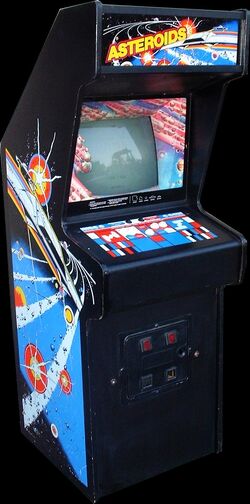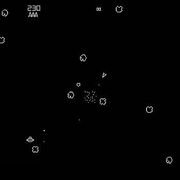
Asteroids is a space shooter arcade game released in 1979 by Atari. It was a fairly popular game as it sold many units. The game is recognizable by many people. The object of the game is to control the spaceship and destroy asteroids and flying saucers to get points. It became Atari's best selling game of all time.
Gameplay[]

Playing a game of Asteroids.
The gameplay is to control the spaceship and destroy things like asteroids and flying saucers for points. The spaceship can be controlled to thrust forward or backwards. The spaceship when pushed forward moves by itself across screen and can go to the edge of the screen and appear on the other side by hyperspace. The ship can turn in any direction and can shoot. When an asteroid is shot it will break into smaller pieces and still can cause damage. The flying saucers appear every now and then try to crash into your ship or shoot you. The asteroids appear on one side of the screen and on the other by hyperspace. Once all asteroids and other objects are destroyed larger ones appear.
Graphics[]
The graphics of the game is that of vector display. That means that the graphics are all made out of lines. The hardware is made out of a DVG (Digital Vector Generator).
Development[]
The creators of Asteroids are Lyle Rains, who created the idea, and Ed Logg who programmed the game. Before Asteroids, Atari were developing a similar game called Lunar Lander. Suprisingly, Asteroids was so popular that they dropped Lunar Lander and created more Asteroid units.
Sequels[]
Due to the game's success Asteroids had been released in sequels and on consoles. The consoles were the Atari 2600, Atari 5200, and 7800. A sequel was made called Asteroids Deluxe and had similar gameplay, but the graphics were colored blue and a shield was added. Later on the original game and others were released on consoles such as the X-Box and Nintendo 64 known as Atari Anthrology. Infrogames released an addition on the Dreamcast and PCs. Another game created was called Space Duel.
Top list of Video games[]
The Killer List of Video Games named it the seventh best video game.
Legacy[]
Due to the game's success, a sequel followed in 1980 dubbed Asteroids Deluxe. Though similar to the original game, several changes and additions occurred, with the onscreen objects now tinted blue and a shield that depleted with use replacing the hyperspace feature. In addition a new enemy dubbed a killer satellite was added to the game, and would break apart into two smaller ships that homed on the player's position if shot. Another two sequels followed this, Space Duel in 1982 and Blasteroids in 1987.The Killer List of Videogames (KLOV) credits this game as one of the "Top 100 Videogames." Readers of the KLOV credit it as the seventh most popular game.
The gameplay in Asteroids was imitated by many games that followed. For example, one of the objects of Sinistar is to shoot asteroids in order to get them to release resources which the player needs to collect.
Ports[]
Asteroids has been ported to multiple systems, including many of Atari's systems (Atari 2600, 7800, Atari Lynx) and many others. The 2600 port was the first game to utilize a bank-switched cartridge, doubling available ROM space. A port was in development for the 5200 and advertised as a launch title but never officially released, although an unofficial release was produced by AtariAge. 1993 saw a release for PCs with Windows 3.1 as part of the original Microsoft Arcade package. Also, a new version of Asteroids was developed for PlayStation, Nintendo 64, Windows, and the Game Boy Color in the late 1990s.
High Scores[]
On November 13, 1982, 15-year-old Scott Safran of Cherry Hill, NJ, set a world record of 41,336,440 points on the classic arcade game Asteroids. He beat the 40,101,910-point score set by Leo Daniels of Carolina Beach on February 6, 1982. To congratulate Safran on his accomplishment, the Twin Galaxies Intergalactic Scoreboard searched for him for four years, until 2002, when it was discovered that he had died in an accident in 1989. In a ceremony in Philadelphia on April 27, 2002, Walter Day of Twin Galaxies presented an award to the surviving members of Safran's family, commemorating the Asteroid Champion's achievement.
Trivia[]
In Asteroids, the saucers that attacked your player had names, what were they? Answer: Wally and Beaver (big saucer and little saucer, respectively).
The movie rights for Asteroids was bought by Universal.
Story[]
In a distant and desolate universe, where the darkness of space stretches infinitely, a lone space pilot finds themselves on a mission of survival and skill. This is the story of "Asteroids", a game that takes you into the depths of the cosmos, where danger lurks in the form of wandering asteroids and enemy ships. The player takes control of a spacecraft, represented by an iconic white triangle, on a playing field that simulates the void of space. Surrounded by asteroids drifting in all directions, the objective is simple yet challenging: survive. Each asteroid destroyed fragments into smaller pieces, increasing the difficulty and danger. As the player progresses, the intensity increases. In addition to asteroids, enemy ships sporadically appear, adding an additional level of threat. These enemy ships, known as "UFOs", fire at the player's ship, creating an even more hostile environment.
The game has no defined end. The player's mission is to accumulate as many points as possible by destroying asteroids and enemy ships, while deftly dodging the dangers around them. Each level surpassed increases the speed and number of asteroids, continuously challenging the player's skill and reflexes. "Asteroids" is a story of endurance, quick reflexes, and overcoming challenges. In this endless universe, space is an unforgiving adversary, but also a playground where only the most skilled can leave their mark in the cosmos. With each game, the player writes their own story of survival in this timeless classic of video games.